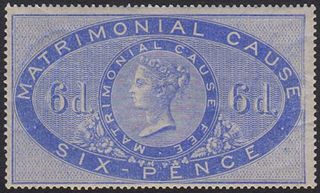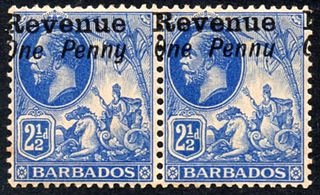
The Lesser Antilles are a group of islands in the Caribbean Sea. Most of them are part of a long, partially volcanic island arc between the Greater Antilles to the north-west and the continent of South America. The islands of the Lesser Antilles form the eastern boundary of the Caribbean Sea where it meets the Atlantic Ocean. Together, the Lesser Antilles and the Greater Antilles make up the Antilles. The Lesser and Greater Antilles, together with the Lucayan Archipelago, are collectively known as the West Indies.
The Leeward Islands are a group of islands situated where the northeastern Caribbean Sea meets the western Atlantic Ocean. Starting with the Virgin Islands east of Puerto Rico, they extend southeast to Guadeloupe and its dependencies. In English, the term Leeward Islands refers to the northern islands of the Lesser Antilles chain. The more southerly part of this chain, starting with Dominica, is called the Windward Islands. Dominica was originally considered a part of the Leeward Islands, but was transferred from the British Leeward Islands to the British Windward Islands in 1940.

The British West Indies (BWI) were colonised British territories in the West Indies: Anguilla, the Cayman Islands, Turks and Caicos Islands, Montserrat, the British Virgin Islands, Antigua and Barbuda, The Bahamas, Barbados, Dominica, Grenada, Jamaica, Saint Kitts and Nevis, Saint Lucia, Saint Vincent and the Grenadines, British Guiana and Trinidad and Tobago. Other territories include Bermuda, and the former British Honduras. The colonies were also at the centre of the transatlantic slave trade, around 2.3 million slaves were brought to the British Caribbean. Before the decolonisation period in the later 1950s and 1960s the term was used to include all British colonies in the region as part of the British Empire. Following the independence of most of the territories from the United Kingdom, the term Commonwealth Caribbean is now used.

The British Leeward Islands - Antigua, Dominica, Montserrat, Nevis, St. Christopher, and the Virgin Islands all used postage stamps inscribed "LEEWARD ISLANDS" between 1890 and 1 July 1956, often concurrently with stamps inscribed with the colony's name.

The British Leeward Islands was a British colony from 1671 to 1958, consisting of the English overseas possessions in the Leeward Islands. It ceased to exist from 1816 to 1833, during which time it was split into two separate colonies. It was dissolved in 1958 after the separation of the British Virgin Islands, and the remaining islands became parts of the West Indies Federation.

The flag of the British Leeward Islands was the flag of the Federal Colony of the Leeward Islands. It was a Blue Ensign with a badge. The colonies under the Federal Colony had their own badges from 1909. The Governor-in-chief of the Leeward Islands used a Union Flag defaced with the coat of arms.
The Leeward Islands Cricket Association, also known as the Leeward Islands Cricket Board, is the ruling body for cricket in the following Caribbean islands: Anguilla, Antigua and Barbuda, the British Virgin Islands, Montserrat, Nevis, Saint Kitts, Sint Maarten, and the United States Virgin Islands. Dominica is geopgraphically a part of the Leeward Islands, but as it was part of the Windward Islands colony from 1940 until its independence, its cricket federation remains a part of the Windward Islands although it did participate in the first Leeward Islands tournament and was a founding member of the Leeward Islands Cricket Association in 1913.

The colony of the British Virgin Islands has issued its own stamps since 1866. The first Post Office was opened in Tortola in 1787. At the time postage stamps were not yet invented, and it was not until 1858 that a small supply of adhesive stamps issued by Great Britain depicting Queen Victoria were utilized by the local Post Office. These stamps were cancelled by an A13 postmark and are extremely rare so cancelled.

Montserrat is a British Overseas Territory in the Leeward Islands.

Nevis, a British colony in the Leeward Islands, began issuing stamps in 1861.
Saint Kitts and Nevis is an island country in the Leeward Islands, consisting of the islands of Saint Kitts and Nevis. In 1883, St. Kitts, Nevis and Anguilla were united into one colony. Anguilla formally separated from the union in 1980.

Revenue stamps of the United Kingdom refer to the various revenue or fiscal stamps, whether adhesive, directly embossed or otherwise, which were issued by and used in the Kingdom of England, the Kingdom of Great Britain, the United Kingdom of Great Britain and Ireland and the United Kingdom of Great Britain and Northern Ireland, from the late 17th century to the present day.
The Australian state of Western Australia issued revenue stamps from 1881 to 1973. There were various types for different taxes.

The island of Antigua issued revenue stamps from 1870 to 1876. The island's short life as a revenue stamp-issuing country was mainly due to the use of postage stamps for most fiscal purposes from 1862 to 1870, and again from 1890 onwards. Therefore, the only revenues issued are more commonly found mint than used. The first set was issued in 1870 and it consisted of eleven values from 1d to 10s, and four of these values were reprinted in 1876 with a different watermark. This makes a total of just fifteen revenues, with most sought after one being the 10s stamp of 1870.

The island of Cyprus first issued revenue stamps in 1878 and continues to do so to this day. The Turkish Republic of Northern Cyprus also issues its own revenue stamps.

Trinidad and Tobago, formerly divided as two separate colonies, issued revenue stamps from 1879 to around 1991.

The island of Barbados first issued revenue stamps in 1916. There were various types of fiscal stamps for different taxes.
Revenue stamps of Seychelles were first issued in 1893, when the islands were a dependency of the British Crown Colony of Mauritius. The first stamps were Mauritius Internal Revenue stamps depicting Queen Victoria overprinted for use in Seychelles, and Bill stamps were also similarly overprinted. Postage stamps depicting Victoria or Edward VII were overprinted for fiscal use at various points between 1894 and 1904, while surcharges on Bill stamps were made in around 1897–98.
Revenue stamps of Montserrat were first issued in 1866, ten years before the island issued its first postage stamps. The island only issued two different designs of revenue stamps, but postage stamps were widely used for fiscal purposes and are still used as such today.
Revenue stamps of Dominica were first issued in 1877, when the island was under British rule. Dominica issued very few revenue stamps, but dual-purpose postage and revenue stamps were widely used for fiscal purposes.












